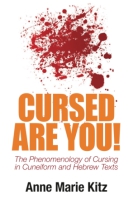Cursed Are You!
The Phenomenology of Cursing in Cuneiform and Hebrew Texts
Anne Marie Kitz
This is a book about curses. It is not about curses as insults or offensive language but curses as petitions to the divine world to render judgment and execute harm on identified, hostile forces.
- Description
- Table of Contents
In the ancient world, curses functioned in a way markedly different from our own, and it is into the world of the ancient Near East that we must go in order to appreciate the scope of their influence. For the ancient Near Easterners, curses had authentic meaning. Curses were part of their life and religion. They were not inherently magic or features of superstitions, nor were they mere curiosities or trifling antidotes. They were real and effective. They were employed proactively and reactively to manage life’s many vicissitudes and maintain social harmony. They were principally protective, but they were also the cause of misfortune, illness, depression, and anything else that undermined a comfortable, well-balanced life. Every member of society used them, from slave to king, from young to old, from men and women to the deities themselves. They crossed cultural lines and required little or no explanation, for curses were the source of great evil. In other words, curses were universal.
Because curses were woven into the very fabric of every known ancient Near Eastern society, they emerge frequently and in a wide variety of venues. They appear on public and private display objects, on tomb stelae, tomb lintels, and sarcophagi, on ancient kudurrus and narûs. They are used in political, administrative, social, religious, and familial contexts. They are the subject of incantations. They are tools that exorcise demons and dispel disease; they ban, protect, and heal.
This is the phenomenology of cursing in the ancient Near East, and this is what the present work explores.
Preface
Abbreviations
Chronology of Languages
Introduction: Curse in the Ancient Near East
Part 1 The Operation of Curses
1. Recent Scholarly Approaches to Curses
2. Vows, Oaths, and Curses
3. The Types of Curses
4. Conditional Cursing
5. The Effectiveness of Maledictions by the Deities
6. The Productivity of Curses by Human Beings
7. Executioner Deities, Hypostatization, and the Agents of Curses
Part 2 Cursing and Society
8. The Purpose of Curses
9. The Process behind Curses
10. Barriers, Boundaries, and Written Display Curses
11. Of Nets and Arms and Webs of Words: Drawing Circles and Twisting Cords
12. Of Nets and Arms and Webs of Words: Weapons and Other Images
13. Curse Management
14. Curse Practitioners: The Lay Curser
15. Curse Practitioners: The Professionals
16. Curse Practitioners: Antagonistic Semi-professionals
17. Curse-Acts
Bibliography
Index of Authors
Index of Scripture
Index of Cuneiform Sources
Mailing List
Subscribe to our mailing list and be notified about new titles, journals and catalogs.




